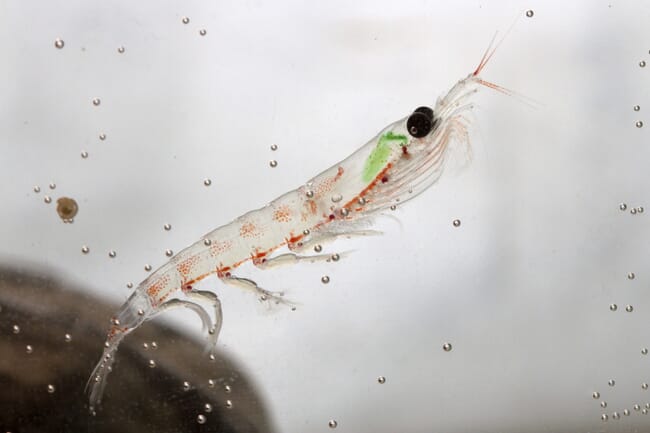
© Aker BioMarine
A new report by Cicero notes that, by replacing ingredients such as soy and fishmeal that have a higher CO2 footprint, krill contributes to lowering the CO2 emissions in the value chain and is a source of sustainable feed for aquaculture producers. This is important because the carbon emissions of many farmed aquatic animals, such as salmon, mostly come from the production of feed.
Cicero conducted a research-based report on Aker BioMarine's governance, revenue streams and investments. The report concludes that “Antarctic krill is a source of sustainable aquaculture feed with positive climate contribution potential”.
The fact that Aker BioMarine has a high sustainability standard when it comes to krill harvesting in Antarctica and that the company has a clear strategy for making the vessels that catch krill more sustainable were also contributing factors for Cicero when giving the “medium green” classification.
“Cicero Shades of Green is impressed by Aker BioMarine’s proactive approach to climate change issues – both in terms of mitigating negative effects and capitalizing on opportunities. This is exhibited by their recent investments in new and energy-efficient vessels that help to reduce greenhouse gas emissions, and their establishment of a circular economy company,” says Harald Francke Lund, CEO of Cicero.
Aker BioMarine's vessels Antarctic Endurance and Antarctic Provider are more energy-efficient than the older vessels and therefore emit less CO2 per unit produced.
Making aquaculture more sustainable
“Aker BioMarine wants to contribute to the aquaculture industry by helping our customers make more responsible choices and be in the forefront of the sustainability agenda in our industry,” says Sigve Nordrum, EVP animal health and nutrition at Aker BioMarine.
In the last ten years, Aker BioMarine has halved its CO2 emissions per tonne of krill produced. The ambition is to half this again within the next 10 years. The company has laid out key performance indicators on how the 2030 targets will be reached.
Within the aquaculture segment, Aker BioMarine:
- Will make aquaculture more efficient by contributing to 1 billion extra servings of seafood produced annually.
- Actively engages with stakeholders and research efforts on conservation and the sustainable management of Antarctica’s resources, and has obtained certifications for relevant products.
- Uses eco-harvesting technology that brings live krill on board the vessels and prevents the unnecessary by-catch such as birds and sea mammals.
- Aker BioMarine’s newest krill harvesting vessel is purpose-built and the company has estimated it to be 30 percent more energy efficient than comparable harvesting vessels.
In 2020 Aker BioMarine joined an industry collaboration platform called Råvareløftet, to reduce the carbon footprint of Norwegian salmon. The purpose of Råvareløftet is to accelerate the phasing in of new and sustainable raw materials for fish feed in order to enable increased production of seafood while reducing the overall climate and environmental footprint of the aquaculture industry.
The full Aker BioMarine company assessment is now available.




